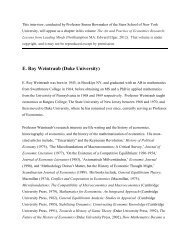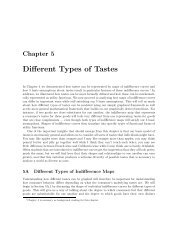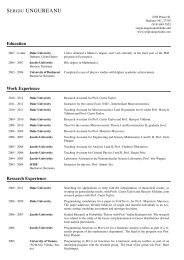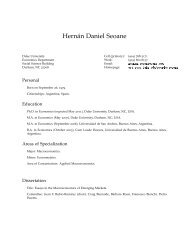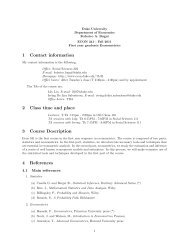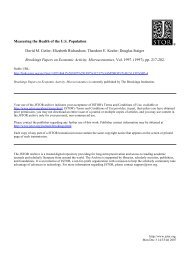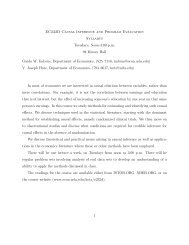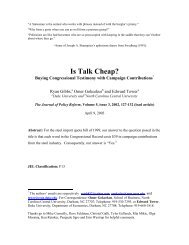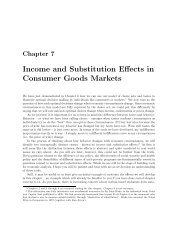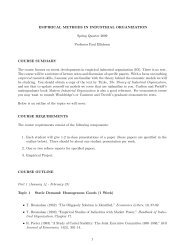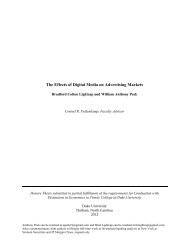Kelly C. Bishop - Duke University | Economics
Kelly C. Bishop - Duke University | Economics
Kelly C. Bishop - Duke University | Economics
You also want an ePaper? Increase the reach of your titles
YUMPU automatically turns print PDFs into web optimized ePapers that Google loves.
<strong>Kelly</strong> C. <strong>Bishop</strong><br />
Department of <strong>Economics</strong> Cell: (919) 672-3896<br />
Box 90097 Office: (919) 660-8155<br />
<strong>Duke</strong> <strong>University</strong> kelly.bishop@duke.edu<br />
Durham, NC 27708-0097 www.econ.duke.edu/∼kcb19<br />
Education<br />
Ph.D., <strong>Economics</strong>, expected 2008, <strong>Duke</strong> <strong>University</strong>, Durham, NC<br />
M.A., <strong>Economics</strong>, 2006, <strong>Duke</strong> <strong>University</strong>, Durham, NC<br />
M.A., <strong>Economics</strong>, 2002, First Class Honours, <strong>University</strong> College Dublin, Dublin, Ireland<br />
B.A., <strong>Economics</strong> (minor Env. Science), 2000, Cum Laude, Barnard College, Columbia <strong>University</strong>, NY, NY<br />
Research Interests<br />
Environmental <strong>Economics</strong>, Labor <strong>Economics</strong>, Public <strong>Economics</strong>, Applied Econometrics<br />
Dissertation<br />
Title: Models of Location Choice and the Value of Spatially Delineated Amenities<br />
Committee: Christopher Timmins (chair), Peter Arcidiacono, Patrick Bayer, Martin Smith<br />
Working Papers<br />
“A Dynamic Model of Location Choice and Hedonic Valuation,” Job Market Paper<br />
“Recovering the Marginal Willingness to Pay to Avoid Ozone: How Panel Data Can Be Used Easily<br />
Estimate Hedonic Inverse Demand Functions,” with Christopher Timmins<br />
“Single Women’s Labor Supply Elasticities: Trends and Policy Implications,” with Bradley Heim<br />
and Kata Mihaly, revise and resubmit at Industrial and Labor Relations Review<br />
“An Equilibrium Model of Housing and Labor Market Dynamics,” (in progress) with Patrick Bayer,<br />
Alvin Murphy, and Christopher Timmins<br />
Presentations<br />
September 2007 Triangle Resource and Environmental <strong>Economics</strong> Seminar, Raleigh, NC<br />
Emerging Research Presentation<br />
July 2007 NBER Summer Institute, Public Policy and the Environment, Cambridge, MA<br />
Research Sketch<br />
1 of 3
Academic Experience<br />
Spring 2005 to present Department of <strong>Economics</strong>, <strong>Duke</strong> <strong>University</strong>, Durham, NC<br />
Research Assistant, Professor Christopher Timmins<br />
<strong>Kelly</strong> C. <strong>Bishop</strong><br />
Spring 2007 Department of <strong>Economics</strong>, <strong>Duke</strong> <strong>University</strong>, Durham, NC<br />
Teaching Assistant, Environmental <strong>Economics</strong> (second-year Ph.D.)<br />
Spring 2005 and Spring 2006 The World Bank, Development Division and Private Sector Division<br />
Research Assistant, supervised by Christopher Timmins<br />
Fall 2004 to Spring 2006 Department of <strong>Economics</strong>, <strong>Duke</strong> <strong>University</strong>, Durham, NC<br />
Head Teaching Assistant, Intermediate Microeconomics<br />
Fall 2002 to Spring 2003 Department of <strong>Economics</strong>, <strong>University</strong> College Dublin, Dublin, Ireland<br />
Course Instructor, Introductory Microeconomics (evening course)<br />
Teaching Assistant, Intermediate Macroeconomics<br />
Teaching Assistant, Intermediate Microeconomics<br />
Teaching Assistant, Quantitative Techniques for Economists<br />
Fall 2001 to Spring 2002 Department of <strong>Economics</strong>, <strong>University</strong> College Dublin, Dublin, Ireland<br />
Teaching Assistant, Introductory Microeconomics<br />
Honors and Awards<br />
Graduate School Summer Research Fellowship, <strong>Duke</strong> <strong>University</strong>, 2007<br />
President (elected), <strong>Economics</strong> Graduate Student Committee, <strong>Duke</strong> <strong>University</strong>, 2006-2007<br />
Aleane Webb Dissertation Research Fellowship, <strong>Duke</strong> <strong>University</strong>, 2006-2007<br />
Conference Travel Fellowship, <strong>Duke</strong> <strong>University</strong>, 2005 and 2007<br />
Department of <strong>Economics</strong> Summer Research Fellowship, 2006<br />
Deborah Allen Graduate Fellowship, <strong>Duke</strong> <strong>University</strong>, 2003-2004<br />
Graduate School Tuition Scholarship, <strong>Duke</strong> <strong>University</strong>, 2003-present<br />
Computer Skills<br />
Fortran90, Matlab, Stata, TSP; L ATEX, MS-Office; Unix, Windows<br />
References<br />
Christopher Timmins Associate Professor, Department of <strong>Economics</strong>, <strong>Duke</strong> <strong>University</strong><br />
phone: (919) 660-1809, email: timmins@econ.duke.edu<br />
Peter Arcidiacono Associate Professor, Department of <strong>Economics</strong>, <strong>Duke</strong> <strong>University</strong><br />
phone: (919) 660-1816, email: psarcidi@econ.duke.edu<br />
Patrick Bayer Associate Professor, Department of <strong>Economics</strong>, <strong>Duke</strong> <strong>University</strong><br />
phone: (919) 660-1832, email: patrick.bayer@duke.edu<br />
Martin Smith Assistant Professor, Nicholas School of the Environment, <strong>Duke</strong> <strong>University</strong><br />
phone: (919) 613-8028, email: marsmith@duke.edu<br />
Emma Rasiel (Teaching) Dir. of Undergraduate Studies, Department of <strong>Economics</strong>, <strong>Duke</strong> <strong>University</strong><br />
phone: (919) 660-1837, email: emma.rasiel@duke.edu<br />
2 of 3
<strong>Kelly</strong> C. <strong>Bishop</strong><br />
A Dynamic Model of Location Choice and Hedonic Valuation (Job Market Paper)<br />
Hedonic equilibrium models allow researchers to recover willingness-to-pay for spatially delineated amenities<br />
by using the notion that individuals “vote with their feet.” However, the hedonic literature and, more<br />
recently, the estimable Tiebout sorting model literature, has largely ignored both the costs associated with<br />
migration (financial and psychological), as well as the forward-looking behavior that individuals exercise<br />
in making location decisions. Each of these omissions could lead to biased estimates of willingness-to-pay.<br />
Building upon the dynamic migration models from the labor literature, I estimate a fully dynamic model<br />
of individual migration at the national level that explicitly controls for moving costs and forward-looking<br />
behavior. By employing a two-step estimation routine, I avoid the computational burden associated with<br />
the full recursive solution and can then include a richly-specified, realistic state space. With this model,<br />
I am able to perform non-market valuation exercises and learn about the spatial determinants of labor<br />
market outcomes in a dynamic setting. Including dynamics has a significant positive impact on the estimates<br />
of willingness-to-pay for air quality. In addition, I find that location-specific amenity values can<br />
explain important trends in observed migration patterns in the United States.<br />
Recovering the Marginal Willingness to Pay to Avoid Ozone:<br />
How Panel Data Can Be Used Easily Estimate Hedonic Inverse Demand Functions<br />
(with Christopher Timmins)<br />
Over the last thirty years, property value hedonics have become commonplace in the non-market valuation<br />
of environmental amenities. This has happened despite a number of well-known problems with the<br />
technique. Bajari and Benkard (2005) describe one of these problems; the traditional “two-step” approach<br />
for estimating preferences proposed by Rosen (1974) places strict constraints on individual heterogeneity<br />
in willingness-to-pay. This problem becomes more severe as one is forced to further restrict preferences in<br />
order to solve the endogeneity problems described by Epple (1987). Bajari and Benkard propose a “preference<br />
inversion” procedure for recovering individual-specific measures of willingness-to-pay. However, with<br />
typically available data their proposed measure of willingness-to-pay suffers from a number of unrealistic<br />
constraints (e.g., willingness-to-pay cannot vary with the level of the amenity). In this paper, we show<br />
how panel data describing repeat house sales, along with repeat purchase decisions by individual home<br />
buyers, can be used to relax these constraints and flexibly estimate willingness-to-pay functions. Using<br />
data on ozone pollution in the Bay Area of California, we find evidence of significant heterogeneity in<br />
willingness-to-pay and in the elasticity of willingness-to-pay with respect to both ozone and non-housing<br />
expenditures. This heterogeneity has important consequences for the valuation of non-marginal changes<br />
in ozone. In ongoing research, we explore how a “synthesized panel” (created using matched individuals<br />
from multiple markets) might be similarly used to relax functional form constraints while recovering the<br />
individual heterogeneity allowed by Bajari and Benkard’s approach.<br />
3 of 3



